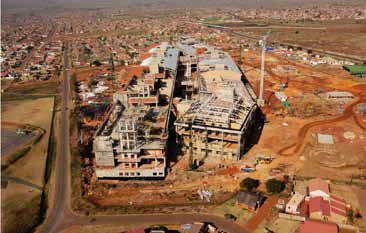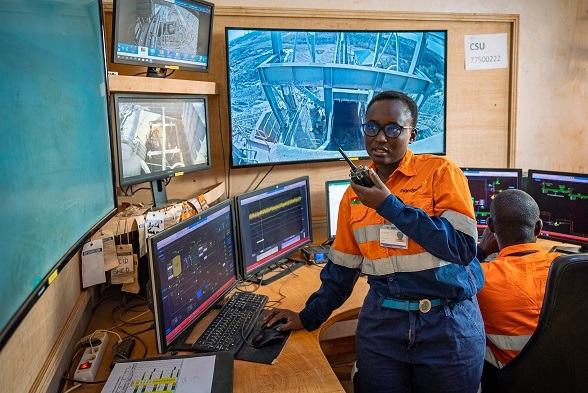
South Africa is putting great effort into improving living standards for its more disadvantaged citizens, as Alan Swaby discovers.
No doubt the World Cup in South Africa made a huge difference to the country as a whole in terms of roads, railway stations and airports; but that is little comfort to those citizens whose local medical centres had a poor reputation. No wonder that politicians in Gauteng felt the hot wind of public opinion on their necks when the populace felt funds were being diverted from promised new hospital wards to sports arenas.
The New Natalspruit Hospital currently being built in Vosloorus, some 40 kilometres east of Johannesburg, will be a flagship hospital within the South African medical system. Where the average hospital has around 400 beds, the new one—at a cost of R1.5 billion—will have 760.
Its construction has been an odd mix of rush and stop-start ever since the plan was first mooted back in 2004. The project managers, on behalf of two Gauteng government departments (Health and Infrastructure Development), is a joint venture between the companies MOA and BKS. Gideon Grobler of BKS Johannesburg is the resident engineer and one of the project managers. “A project of this size,” he says, “would normally need about 12 months to design and plan before going out to tender but for a whole series of reasons, not least of which is the need to replace the physically precarious existing hospital, we had to do that in just five months.”
Throughout the development there has been disagreement between the various interested parties and at times, the budgeted funds have not always been forthcoming. As such, following periods of reduced activity, the pressure has been even greater to complete quickly. Despite everything, construction is currently on track to be completed by December this year and the construction commissioning by March 2012.
Lead architects on the project are Osmond Lange Architects & Planners; and Deon Van Onselen explains the design strategy behind the hospital. “Compressing the development phase in this way meant that we had no option but to go for a totally modular approach where space usage could be modified at any stage. To get general contractor Basil Read off the ground, we developed a kit of parts that enabled the superstructure to accommodate all possibilities.” Justifiably, both Grobler and Van Onselen are pleased that the original designs have been proved 90 per cent accurate.
With so much uncertainty over exactly what goes where, the whole structure has been built with a strong service rationale. “Each level of the building,” explain Van Onselen and Grobler, “has 1.5 metres of space above the ceiling. Together with major vertical ducts and defined horizontal and vertical service zones, this means that we have been able to install all the services for the building without disruption and minimal clashes.”
The hospital is being built on the site of a previous sports ground which first had to be relocated before the hospital proper could begin. Unlike the hospital it is replacing, the new building has the advantage of solid bedrock rather than dolomite. In terms of shape, the 70,000 square metre complex comprises two parallel banks of four buildings connected together either side of a public-friendly pedestrian ‘High Street’, with the two banks linked by elevated walkways and link bridges.
Although not governed by any formulised guidelines, the structure has been designed with a greenish pen. Natural light and ventilation play an important role in giving the hospital a light and airy feel. In order to test the various colours, materials and fittings which will be ultimately used, a test ward has been set up so that all interested parties can inspect and comment before committing.
The lower ground floor will be for the exclusive use of staff offices, kitchen and workshops while the ground floor, first, second and third levels will house consulting and treatment rooms as well as hospital wards. The centre will cater for a wide spectrum of general medicine with the usual array of diagnostic equipment found in all modern hospitals. The nature of the region which the hospital serves has put particular emphasis on certain activities. As well as an extensive maternity wing, there is sadly the need for a dedicated burns department. “This area has a mix of middle class and much poorer residents,” says Van Onselen, “many of whom are living in rural areas and relying on open fires for cooking and heating. Not surprisingly, there are a lot of accidents involving burns.”
As well as the main buildings, the contract includes the construction of a series of outbuildings, one of which—the Family Medicine Centre—will act as a gateway to the hospital, with triage medical staff deciding how best to treat incoming patients.
As is often the case in South Africa, there is a political hook attached to this project. A condition of the contract is that 60 per cent of labour comes from the immediate vicinity. In other words, as well as a much needed health facility, the hospital is also a gigantic work creation project and skills training programme. “There are over seven million bricks to be laid in this building,” says Grobler, “and many of them will be the work of newly trained bricklayers. Basil Read has put together mixed teams in terms of expertise, where experienced tradesmen pass on their knowledge while on the job. At the same time, though, Basil Read has to carry the financial risk of wasted materials and guaranteed quality levels.”
The hospital is expected to serve the community for many years, with materials and fittings being selected accordingly. The north-facing solar control screens, for example, are all galvanised to make them maintenance-free, while a curved roofline has been chosen in preference to flat in order to minimise leakage problems.
South Africa’s national and provincial governments are drawing up plans for a new round of hospital developments that could outspend the money which went into the World Cup. Not all of this will be public money and PPP initiatives will play a major role in upgrading medical facilities. The lessons learnt from the New Natalspruit Hospital will find their way into new developments, delivering value for money coupled with new hope for a better life for local inhabitants.
* * *



 NEW_Natalspruit_Hospital_MAY11_emea-bro-s.pdf
NEW_Natalspruit_Hospital_MAY11_emea-bro-s.pdf









